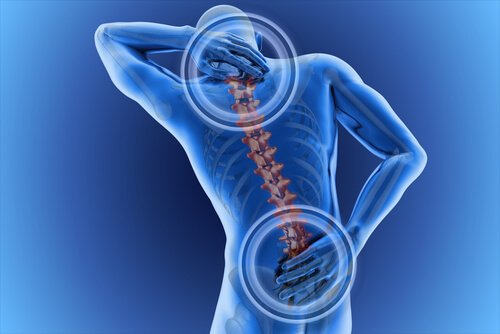What Effect Do Emotions Have on Your Back?


Written and verified by the psychologist Valeria Sabater
Plato said that the body is the soul’s prison. Sometimes it’s less of a friend than a messenger that tells you when something hurts that something is wrong. So if you’ve ever wondered how emotions might affect your back, there’s a pretty clear answer. They can cause cramps, tension, and pain that medicine can’t always relieve.
Back pain is one of the most common problems all over the world, next to headaches. It’s estimated that every 1 in 10 people gets it often, and it’s one of the biggest reasons people take sick days from work.
There are also many different things that can lead to back pain. The list includes bad ergonomics at work, hernias, kidney problems, osteoporosis, arthritis, disc degeneration, etc. But there’s another factor that most people overlook.
Like you probably guessed, we’re talking about the mind-body connection. But our specific focus here is emotions and their impact on this complex, fascinating combination of bones, ligaments, tendons, muscles, invertebral spaces, joints, and nerves.
Things like stress and anxiety cause small changes in all of these physical structures. Little by little, they lead to inflammation, lack of coordination, and periods of time that are so painful they affect your quality of life.

What effect do emotions have on your back?
The ways that emotions affect our back are as different as they are interesting. There are some specialists who have no problem saying that our spinal column doesn’t just support our physical weight, it also deals with our emotions.
Our back is like the pillar of our lives, and we’re not saying that in any spiritual sense. Just think about what its whole purpose is: to protect and encase our delicate nervous system.
Having lower back pain, cramps, or — even worse — chronic back pain can completely paralyze you. It can force you to stop everything. But that pain is really just like a loyal watchdog guarding your house.
When there’s any kind of danger, it barks. Making it be quiet with pills won’t help you at all if you don’t know what’s causing the problem. You have to figure out what’s threatening your “body’s pillar,” the balance point of your life.
Sadness, worry, stress, and their relationship to your back
As strange as it might sound, back pain is actually one of the most common physical symptoms for people with depression and anxiety.
That’s why you see so many people go through endless physiotherapists and back specialists. They can’t find relief. They can’t find a cure for their recurring back pain, at least not until they finally get the right diagnosis from a psychologist or other mental health professional.
You can’t forget that pain is really just a neurological phenomenon that our nervous system sends through our body. So when you’re distressed, afraid, disappointed, or down, what that means is there’s a chemical imbalance in your brain. For example, irregularities with serotonin and norepinephrine generally give you a higher level of pain perception.

Stress and anxiety also lead to higher amounts of cortisol in your blood. That’s important because it’s the hormone that increases your blood flow and muscle tension.
It also starts up certain autoimmune processes that might attack your joints, inflame your nerves, and even reduce the calcium in your bones.
Emotional pain and back pain
Swimming, anti-inflammatories, muscle relaxants… None of those things work when your back problems are really coming from emotional pain. There’s even an article in Psychology Today about this.
They say that emotional problems are a sign that something inside you is broken, messed up. The invisible wound usually comes out in the form of back pain, headaches, digestive problems, etc.
There are some places, like the Duke University Medical Center, that specialize in treatment for conditions like this. Dr. Benson Hoffman says that 80% of us go through back pain at some point in our lives.
It’s the most common problem in human beings. He wants to show that our emotions do have an effect on our back, and that emotional problems like sadness or disappointment center around that part of our body. It’s an absolutely fascinating, eye-opening topic.
How to prevent and treat back pain related to your emotions
Take a second to picture something. Imagine that you have a quiver on your back. It’s a quiver full of arrows to help you get rid of pain, deal with it better, and defend yourself from anything that might stick to you and turn into a problem.
- One way of making sure you have enough arrows in your quiver is by doing biofeedback therapy. It’s a kind of practice that shows you how to improve your health by becoming more aware of things like your blood pressure, heart rate, and muscle tension. It basically means training your brain to work for you. You do that by paying attention to bodily processes that you’ve never paid any attention to before.
- Cognitive-behavioral therapy can be a big help too. It’s an amazing way to get more control of your thoughts, process your emotions, and encourage yourself to make better, healthier behaviors a habit.
- It’s pretty clear how emotions affect our backs. So there’s no reason not to try different techniques to figure out what works best for you. The American Chronic Pain Association even has some recommendations. You can do things like add more vitamin B to your diet or use something called “distraction techniques.” These basically involve training yourself to think about specific images, smells, or songs to distract you from your pain.

What are you waiting for?
Now you know the effect that emotions have on your back. So how about learning how to prevent it? Put care into your emotions just like you do with your diet, and never forget about movement.
A body that moves and a mind that clears itself up every once in a while are the secrets to good health. So what are you waiting for? Get moving!
All cited sources were thoroughly reviewed by our team to ensure their quality, reliability, currency, and validity. The bibliography of this article was considered reliable and of academic or scientific accuracy.
- Burns, J. W., Gerhart, J. I., Bruehl, S., Peterson, K. M., Smith, D. A., Porter, L. S., Schuster, E., Kinner, E., Buvanendran, A., Fras, A. M., & Keefe, F. J. (2015). Anger arousal and behavioral anger regulation in everyday life among patients with chronic low back pain: Relationships to patient pain and function. Health psychology : official journal of the Division of Health Psychology, American Psychological Association, 34(5), 547–555. https://pubmed.ncbi.nlm.nih.gov/25110843/
- Chen, S., Chen, M., Wu, X., Lin, S., Tao, C., Cao, H., … & Xiao, G. (2022). Global, regional and national burden of low back pain 1990–2019: a systematic analysis of the Global Burden of Disease study 2019. Journal of orthopaedic translation, 32, 49-58. https://www.sciencedirect.com/science/article/pii/S2214031X21000590
- Cherkin, D. C., Sherman, K. J., Balderson, B. H., Cook, A. J., Anderson, M. L., Hawkes, R. J., Hansen, K. E., & Turner, J. A. (2016). Effect of Mindfulness-Based Stress Reduction vs Cognitive Behavioral Therapy or Usual Care on Back Pain and Functional Limitations in Adults With Chronic Low Back Pain: A Randomized Clinical Trial. JAMA, 315(12), 1240–1249. https://pubmed.ncbi.nlm.nih.gov/27002445/
- Du, S., Hu, Y., Bai, Y., Hu, L., Dong, J., Jin, S., & Zhang, H. (2019). Emotional Distress Correlates Among Patients With Chronic Nonspecific Low Back Pain: A Hierarchical Linear Regression Analysis. Pain practice : the official journal of World Institute of Pain, 19(5), 510–521. https://pubmed.ncbi.nlm.nih.gov/30739397/
- Esteves, J. E., Wheatley, L., Mayall, C., & Abbey, H. (2013). Emotional processing and its relationship to chronic low back pain: results from a case-control study. Manual therapy, 18(6), 541–546. https://pubmed.ncbi.nlm.nih.gov/23756033/
- Ehrlich, G. (2003).Low back pain. Bulletin of the World Health Organization, 81 (9), 671 – 676. https://apps.who.int/iris/handle/10665/269016
- Grabovac, I., & Dorner, T. E. (2019). Association between low back pain and various everyday performances : Activities of daily living, ability to work and sexual function. Wiener klinische Wochenschrift, 131(21-22), 541–549. https://www.ncbi.nlm.nih.gov/pmc/articles/PMC6851039/
- Harvard Medical School. (2016, 5 de abril). The psychology of low back pain. https://www.health.harvard.edu/blog/psychology-low-back-pain-201604259537
- Hashmi, J. A., Baliki, M. N., Huang, L., Baria, A. T., Torbey, S., Hermann, K. M., Schnitzer, T. J., & Apkarian, A. V. (2013). Shape shifting pain: chronification of back pain shifts brain representation from nociceptive to emotional circuits. Brain : a journal of neurology, 136(Pt 9), 2751–2768. https://www.ncbi.nlm.nih.gov/pmc/articles/PMC3754458/
- Karp, J. F., Yu, L., Friedly, J., Amtmann, D., & Pilkonis, P. A. (2014). Negative affect and sleep disturbance may be associated with response to epidural steroid injections for spine-related pain. Archives of physical medicine and rehabilitation, 95(2), 309–315. https://www.ncbi.nlm.nih.gov/pmc/articles/PMC4008542/
- Konno, S. I., & Sekiguchi, M. (2018). Association between brain and low back pain. Journal of orthopaedic science : official journal of the Japanese Orthopaedic Association, 23(1), 3–7. https://pubmed.ncbi.nlm.nih.gov/29167069/
- MedlinePlus. (s. f.). Pain and your emotions. Consultado el 5 de mayo de 2023.
https://medlineplus.gov/ency/patientinstructions/000417.htm - Ouchi, K., Watanabe, M., Tomiyama, C., Nikaido, T., Oh, Z., Hirano, T., Akazawa, K., & Mandai, N. (2019). Emotional Effects on Factors Associated with Chronic Low Back Pain. Journal of pain research, 12, 3343–3353. https://www.ncbi.nlm.nih.gov/pmc/articles/PMC6925544/
- Trief, P. M., Grant, W., & Fredrickson, B. (2000). A prospective study of psychological predictors of lumbar surgery outcome. Spine, 25(20), 2616–2621. https://pubmed.ncbi.nlm.nih.gov/11034646/
- Watanabe, M., Tomiyama, C., Nikaido, T., Takeda, T., & Mandai, N. (2023). Mental status is significantly associated with low back pain: a survey-based cross-sectional study among Japanese women. BMC Research Notes, 16(1), 1-10. https://bmcresnotes.biomedcentral.com/articles/10.1186/s13104-023-06276-4
This text is provided for informational purposes only and does not replace consultation with a professional. If in doubt, consult your specialist.








